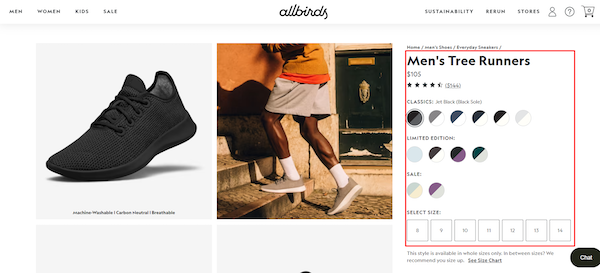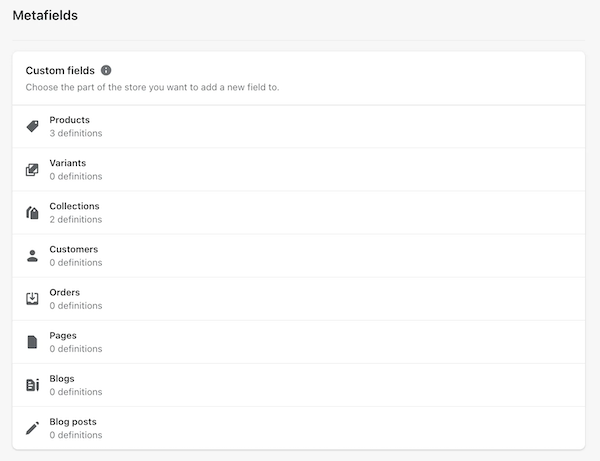What are Shopify Metafields?
One of the most popular features in Shopify is Shopify Metafields, but implementing it can be difficult for novice users. Adding custom fields to a product page and modifying the Shopify filter are just a few examples of how it can be used in Shopify.
Metafields (or custom fields) allow you to add extra information to your store that isn’t already present in the default configuration of Shopify.
For instance, a candle seller might want to list the burn time for candles on their product pages, whereas a grocery store might want to list the product expiration date for canned goods. The following are additional examples of specialized metafield information:
- lists of ingredients
- part numbers
- color swatches
- launch dates
- related products
- blog post summaries
- files for download
- etc.
Shopify’s Color, Date/Date and Time, Dimension, Weight, Volume, Number, Rating, Product reference, File reference, Page reference, URL, and Text metafield content types all allow list inputs.
Why Shopify stores use metafields?
To display more details in an enticing manner
One of the main functions of Shopify metafields is to allow store owners to add information to the product page more flexibly without having to write a single code line.
Metafields allow merchants to add custom fields to their products and other objects in their store that are not available by default in Shopify. This allows merchants to customize their stores to fit their needs and requirements better.
Shopify metafields provide a versatile way to personalize your Shopify store’s functionality and aesthetics. By using metafields, you can create a tailored storefront that delivers exceptional experiences to both new and returning customers, thereby increasing the likelihood of repeat visits and purchases.
Choose Shopify metafields to easily filter, search, and sort your products
When looking for a filter and search Shopify app, the ability to filter or search by metafield is one of the most-wanted features. With metafields, your customers can quickly find almost anything in your store by using any product information.
Let’s check inside this furniture shop. They feature a filter to make it easier for buyers to find things that can be stored or not. Instead of tags or product descriptions, Shopify metafields are a more effective way to display the characteristics of this product.



What are the examples of stores using Metafields?
There are many custom fields available in Shopify that you can use.
1. Product Metafields on Shopify
The most typical one is this one. It enables us to display more details about each product on the product page. For instance, using metafields properly can allow you to display technical specifications like this fashion store:



Source: https://www.allbirds.com/
2. Shopify Variant Metafields
Users of Shopify can add details for each product version using these types of metafields. Sample use of a variant metafield is shown in the image below. The characteristics of the bike will differ depending on the color variant.
3. Shopify Collection Metafields
The extra details of a sale promotion are a great example of this. To generate a sense of urgency, you can add a Metafields definition for the sales information and another one for the countdown timer.
4. Shopify Customer Metafields
Metafields for customer information are a great feature that will help you divide your customers into groups based on their unique information.
Use the following customer segments based on metafields as filters:
- Send tailored emails to groups of clients, such as those who have recently viewed a particular product.
- Customers should be reminded to review their orders by seeing reminders on account sites.
- Create layers of loyalty to divide discounts.
5. Shopify Order Metafields
You may require additional information for your store orders on numerous occasions. Identixweb has listed a few, among these:
- Put a note in your orders.
- Put the items in priority order.
- Mark the order for standard or expedited delivery.
- Give orders ratings
You may now utilize Shopify Order Metafields instead of third-party software in all of these situations and more.
Similarly, the most recent version of Online Store 2.0 allows you to create metafields for Shopify Pages, Shopify Blogs, and Shopify Blog Posts.



Best practices to optimize Shopify metafields
One effective way to modify your Shopify store for a better shopping experience is by adding Shopify Metafields.
Activating filters
Even though Shopify stores come with some filters already set up, store owners can also add their own filters based on a number of factors.
The people who run online stores use popular product filters such as color, size, age, gender, and tags. One of the useful tools in Shopify filters is rearranging the priority. By moving the sections, Shopify merchants can order the filters.
Using “faceted filters,” Shopify store owners can choose and turn on the filters, but it’s not enough to just choose which search suggestions to show for online stores.
Sorting Products
For your Shopify store to organize the products efficiently, you need to set up your products in a number of different ways to make your online businesses unique. Sorting sub-collections is one method for organizing your products on collection pages.
- Adding “Best Sellers” section.
- Adding optimal picture size highlighted images.
- Sorting the items into their proper order.
Modifying the Navigation Bar
Visitors to e-commerce websites will find it easier to make purchases with good navigation. The owner of an eCommerce site should change the menu bar, drop-down menus, theme editors, and URL structures to make navigation easier. The following are some options for modifying the navigation bar on Shopify websites:
- Personalizing the web design.
- Sales channel navigation extension.
- Optimizing breadcrumbs on the site.
- Optimizing the menu bar.
















